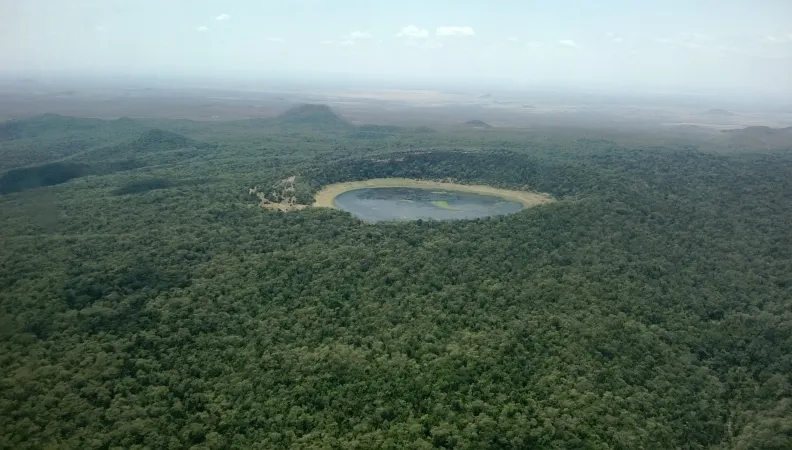Share the page
Conservation project in Northern Kenya (Marsabit)
Project


-
Project start date
-
Status
Completed
-
Estimated date of project termination
-
-
Project financing date
-
-
Financing duration
-
5 ans
-
Type of program
-
FFEM
-
Global financing amount
-
12642000 €
-
FFEM financing amount
-
1500000 €
-
Project lead member institution(s)
-
AFD
-
Country and region
-
Kenya
-
Location
-
Marsabit
-
Type of financing
-
Beneficiaries
-
Northern Rangelands Company Limited (NRCL)
The project aims to improve biodiversity conservation and natural resources management in Northern Kenya. It is focusing on protecting the Marsabit forest, which provides major environmental services, including water supply. It is, at the same time, setting up community reserves around the forest to promote a more effective management of local natural resources (wildlife, water, wood, energy and pasture land) in the context of shared governance.
Context
The Marsabit forest covers an area of 11,000 ha in Northern Kenya over a series of volcanic cones. The heavy dependence of local communities on natural resources and the scarcity of these resources cause recurrent ethnic tensions in the area. Local biodiversity remains relatively rich and comprises animal and plant species that are endangered at national and international level. Due to its remoteness, this region has until now remained outside Kenya’s main tourist routes.
The forest of Marsabit and the low and medium altitude peri-forest ecosystems are ecologically interdependent. There are local migrations of animal species (elephants, Grevy’s Zebras, birds) between the plains and the forest depending on the seasons.
These ecosystems and the forest of Marsabit provide a number of ecological services to local communities. A number of temporary water courses which supply the town of Marsabit (50,000 inhabitants) originate in the forest and recharge the groundwater on the plains, which the livestock of pastoralists are dependent on. In addition, it reduces the local aridity of the climate and supplies communities with products: firewood, medicinal plants, permanent springs and pasture areas during the dry season.
The forest of Marsabit was classified as a Forest Reserve in 1932, then integrated into a National Reserve in 1948 (the boundaries of which have been changed several times). It is managed by the Kenya Wildlife Service and Kenya Forest Service. While these two parastatal entities regularly work together in the field, this dual institutional supervision related to a non-clarified legal status maintains some confusion over the role and responsibility of each institution. This situation poses problems as the forest is under great pressure: between 1973 and 2005, it lost 30% of its surface area (to farmland) and about a quarter of the forest is currently seriously degraded due to illegal fuelwood cutting. At the same time, the average flow of one of the forest’s main permanent springs fell from 150 m3 per hour in 1995 to 2.7 m3 per hour in 2009. The entire ecosystem is jeopardized and, consequently, the ecological services rendered to local communities.
Description
The project is based on six components:
- Improvement in the political and legal framework: definition of guidelines for the implementation of the new law on wildlife, clarification of the legal status of the area, preparation and implementation of a management plan for the park and reserve, creation of three community reserves to the west of the park and, finally, preparation and implementation of a tourism development plan and a water resources management plan.
- Ecosystem conservation: development of infrastructure and equipment for the park, capacity building for the park’s management staff, development of research activities and implementation of an environmental monitoring system for the area.
- Natural resources management: creation and supervision of governance bodies for the three community reserves, support for the environmental and social monitoring system for all the community reserves in Northern Kenya and the development of a sustainable management model for natural resources (water, wood and pasture land) in the three community reserves
- Maintenance of connectivity: the main activities planned are the management of water points on the plains to provide access to migratory wildlife and a strengthening of security on the plains (anti-poaching activities in particular).
- Payment for environmental services: development of tourism in the area and payment for water resources.
- Facilitate the leverage effects of the project: implementation of activities to create synergies with other projects operating in the area and to catalyze activities still outstanding and related to the project (for example, the development plan for the town of Marsabit and the response to the energy demand of the town).
Impacts
- Sustainable management of natural resources in the area, improvement in biodiversity conservation and improvement in the socioeconomic conditions of local communities.
- Protect the key parts of the forest (even if they are relatively small) and contribute to mitigating greenhouse gas emissions.
- The forest is an important stopover area for palearctic migratory birds. Its protection ensures that this migratory route is maintained.
- Protect the ecosystem services provided by Mount Marsabit. Tens of thousands of people rely on these resources and if there was a shortage in the water supply (which would be the case if the forest was not protected), tens of thousands of environmental refugees would be forced to leave the town of Marsabit.


